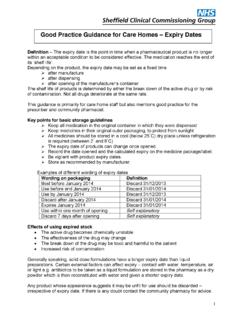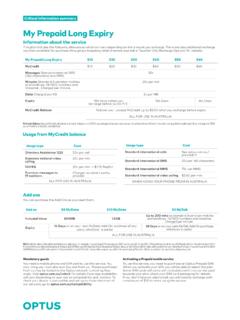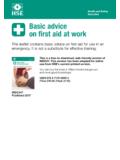Transcription of Expiry Date of Your Universal Life Insurance
1 Expiry date of your Universal life Insurance JIM OTAR hat? you might say, I did not know Universal life Insurance (UL) had an Expiry date ! Relax. You are right. UL does not have an Expiry date as long as you keep paying the premiums on time. In the March issue, Robert Barney raised the issue of the potential problems with UL in his article Storm Clouds Rising? Universal life . What I want to do here is to quantify his concerns in terms of 100 years of market history. In the late 1970 s and early 1980 s the interest rates were very high. A product called vanishing premium Insurance became popular.
2 It had the premise that the high interest rates would be sufficient to pay the cost of Insurance after a number of years, hence the name vanishing premiums . Of course, it did not work. In the mega-bull markets of the 1990 s, a differently engineered product, the UL became popular. This time, the hook was not the roaring interest rates, but the roaring stock markets. That convinced agents and clients into thinking that if they put sufficient dollars into UL, all kinds of wonderful things can happen, including premiums being paid by the investment side of the UL, retiring rich, tax-free retirement income or leaving a large estate.
3 Now that the bear market has been here for the last two years, and Warren Buffett cautioning us not to expect more than 8% annual growth in the stock markets for several years to come, it may be worthwhile to see if your UL plan is still feasible. We are going to look at one thing only: What is the probability that your UL may run out of money and you may need to resume paying premiums to keep your policy intact? Here are my assumptions: The cost of Insurance is constant over the life of your policy. The investment side is invested 50% in fixed income and 50% in market index, rebalanced annually.
4 The return of the equity side of the portfolio is the Dow Jones Industrial Average less 2% MER (management expense ratio) The return on the fixed income side is the 5-year historic return, with 0% MER. I used one hundred years of historic market data between 1900 and 1999 for my study. You may be in one of these four categories: 1. You don t own a UL policy yet but you are evaluating proposals. 2. You own a UL policy, but you do not make any overpayments. You pay only the cost of Insurance . 3. You own a UL policy and you are finished with your scheduled payments.
5 Now the investment side of your policy is paying the cost of the Insurance . 4. You own a UL policy and you are still making accelerated payments. your illustration shows that in a few years your payments are scheduled to stop. If you belong to category 1, your job is easy: ask your agent to give you an illustration with 4% interest rate. If it still looks feasible then you don t need to read the rest of this article. If you belong to category 2 then you don t need to worry either. your policy will continue as long as you keep paying your premiums on time. If you belong to category 3, then you need to figure out your payment rate.
6 First figure out the market value of the investment side of your UL from your latest statement. Then find out the annual cost of your Insurance indicated on your policy. The payment rate is the annual cost of Insurance divided by the market value. Multiply this by 100 to convert it into percentage. If you belong to category 4, you need to figure out the projected payment rate . Make an estimate of the projected market value of the investment side of your UL for the year when you will be making your final scheduled premium. Then find out the annual cost of your Insurance .
7 The projected payment rate is the annual cost of Insurance divided by the projected market value. Multiply this by 100 to convert it into percentage. Now that you have the payment rate , you can estimate when your UL may run out of money. If you figured that your payment rate is 4% or less then you don t need to worry; the chances are that your policy won t expire. WAn example for a payment rate of 7% is shown in Figure 1. It shows the value of the investments in your UL after a number of years. It includes all historic data between 1900 and 1999. The heavy line in the chart shows the projections of a typical UL illustration that may be based on an interest rate of This particular illustration was obviously very optimistic, -as they usually are.
8 The four spikes seen in the middle of the chart are the years 1974 through 1977. The three spikes to the right of the chart are the years 1970, 1971 and 1972. Other than those seven years and a few more, in all other cases, unless you died sooner, you had to put in more money to keep the Insurance policy in force. Next, we go to Figure 2. Does it look familiar? Yes, we used the same type of chart in my Retirement Planning series of articles. The horizontal scale of the chart in Figure 2 shows the payment rate . The vertical scale the number of years in which your UL will expire unless you add more money for the worst-case scenario.
9 There are four different curved lines on the chart. We first focus on the heavy line. It represents 0% probability of Expiry . Using your own payment rate on the horizontal scale, draw a vertical line up to the heavy line on the chart. From there, draw a horizontal line to the vertical scale. On the vertical scale you can read off the worst-case Expiry time in years. For example if your payment rate is 7% then it never expired before 10 years. The three lighter lines above the heavy line represent the probability of Expiry at a given payment rate after a certain number of years.
10 Using the same example, if your payment rate is 7% then by 20 years the probability of Expiry is about 30%. Be aware that all the conclusions are based on one hundred years of market history between 1900-1999. The future performance will be different. Also, we made some assumptions that are different for each policy. For example, if the fixed income portion in your portfolio is higher than 50/50, then portfolio life turns out to be somewhat longer. Jim Otar, CFP, , Independent Financial Advisor, Datile Securities, (905) 889-7170. Jim is the author of High Expectations and False Dreams One Hundred Years of Stock Market History Applied to Retirement Planning , Figure 1: Value of the Investment side of your UL for a payment rate of 7%, equity MER 2%, fixed income MER of 0%, asset mix 50/50, rebalanced each year, all years between 1900-1999 Figure 2: Probability of Expiry , asset mix 50/50







